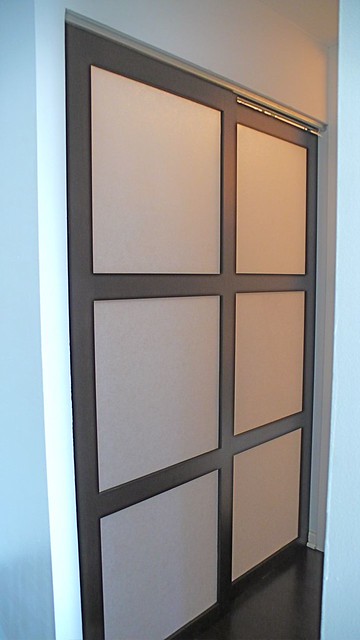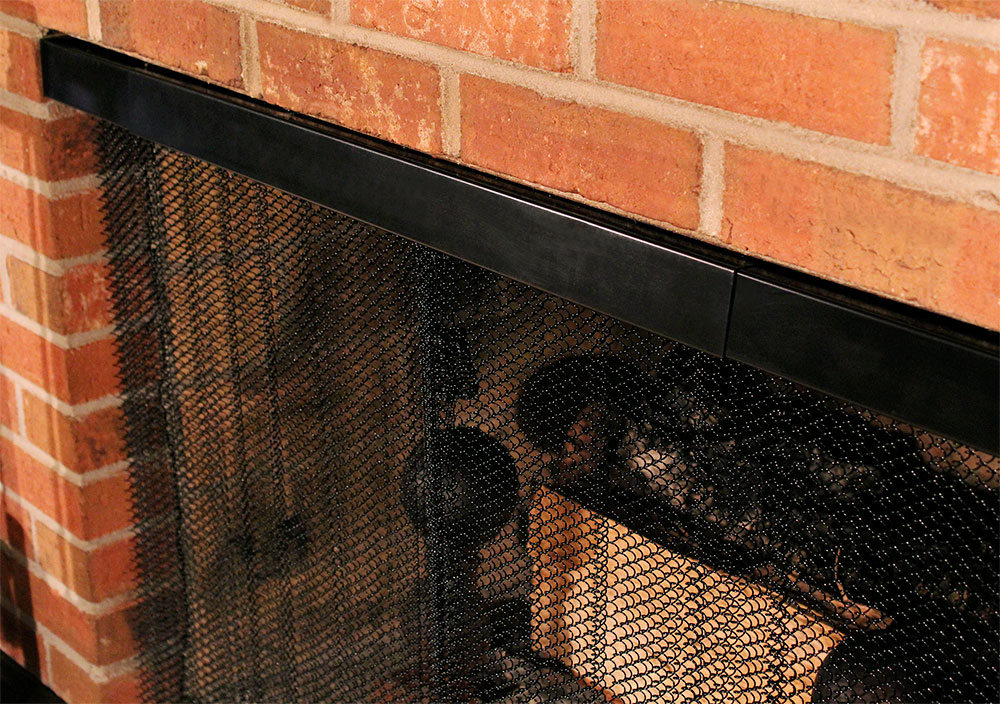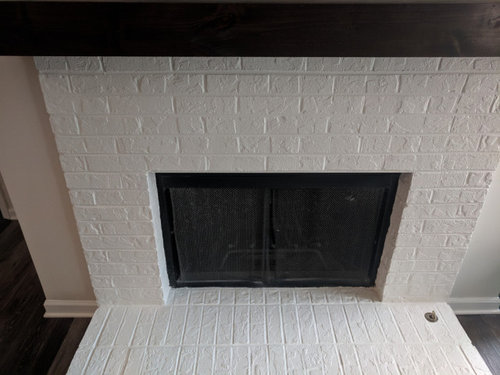Replacing a fireplace screen can be a rewarding and practical home improvement project. Not only does a new screen enhance the aesthetic appeal of your fireplace, but it also improves safety by preventing sparks and embers from escaping into your living space. This article will walk you through the process of replacing your fireplace screen, from understanding the different types available to installation and maintenance.

Understanding the Types of Fireplace Screens
Mesh Screens
Mesh screens are a popular choice for many homeowners due to their simplicity and functionality. These screens are made of finely woven metal mesh that can effectively block sparks and embers while allowing heat to pass through. They are typically mounted on a frame that fits snugly over the fireplace opening.
One of the key benefits of mesh screens is their flexibility. They can be easily moved aside when adding logs to the fire or tending to the flames. Mesh screens are also relatively inexpensive and come in various sizes and styles, making it easy to find one that matches your décor.
However, mesh screens do have some drawbacks. They can accumulate soot and ash, requiring regular cleaning to maintain their appearance and functionality. Additionally, mesh screens may not provide as much of a visual barrier as some homeowners might prefer, allowing a clearer view of the fire but also any ash or debris inside the fireplace.

Glass Fireplace Doors
Glass fireplace doors offer a more permanent and elegant solution compared to mesh screens. These doors are usually made of tempered glass that can withstand high temperatures. They provide a clear view of the fire while offering a solid barrier against sparks and embers.
One of the main advantages of glass doors is their energy efficiency. When closed, they help to prevent warm air from escaping up the chimney when the fireplace is not in use, contributing to better heat retention in your home. Glass doors also require less frequent cleaning compared to mesh screens, as they do not trap soot and ash in the same way.
On the downside, glass fireplace doors can be more expensive than mesh screens and may require professional installation, especially if they need to be custom-fitted to your fireplace. Additionally, they do not allow as much airflow, which can affect the efficiency of your fireplace when the doors are closed.

Folding Screens
Folding screens are a versatile option that can be easily moved and adjusted. They consist of several panels connected by hinges, allowing them to be folded and stored when not in use. Folding screens can be made from a variety of materials, including metal, glass, and even decorative fabric.
The main benefit of folding screens is their portability and ease of use. They can be quickly placed in front of the fireplace when needed and removed just as easily. Folding screens also come in a wide range of designs, from traditional to contemporary, making it easy to find one that complements your home décor.
However, folding screens may not provide as secure a barrier as fixed screens or glass doors, as they can be knocked over if not placed securely. They also do not offer the same level of energy efficiency as glass doors, as they do not seal the fireplace opening.

Curtain Screens
Curtain screens combine the flexibility of mesh screens with the aesthetic appeal of drapery. These screens are made of heavy-duty metal mesh or fabric that hangs from a rod installed above the fireplace opening. They can be drawn open or closed as needed, much like a window curtain.
Curtain screens offer a unique decorative element to your fireplace, with the ability to choose from various colors and patterns to match your interior design. They are also easy to operate and can be more effective at blocking sparks than some other screen types.
The primary drawback of curtain screens is that they can be more challenging to install, requiring proper mounting hardware and potentially custom fitting. Additionally, like mesh screens, they require regular cleaning to remove soot and ash buildup.

Custom Fireplace Screens
For homeowners with uniquely shaped or sized fireplaces, custom screens may be the best option. Custom screens are designed to fit the specific dimensions and aesthetic preferences of your fireplace, ensuring a perfect fit and a cohesive look.
The main advantage of custom screens is their ability to meet specific needs and design preferences. They can be made from a variety of materials and tailored to match the style of your home. Custom screens also provide an opportunity to incorporate unique design elements, such as monograms or intricate patterns.
However, custom screens can be significantly more expensive than standard options and may require professional installation. The lead time for manufacturing and delivery can also be longer, so planning is essential.
Interesting Articles You May Want to Check:
- Decorative Metal Fireplace Screen
- Bed Bath and Beyond Fireplace Screen
- Vintage Peacock Fireplace Screen
- Snowman Fireplace Screen
- Fireplace Screen Rod Kit

Measuring Your Fireplace for a New Screen
Gathering the Necessary Tools
Before you begin measuring your fireplace for a new screen, gather the tools you will need. A tape measure, pencil, and paper are essential for recording measurements. You may also want to have a level on hand to ensure accurate measurements and a straight edge or ruler for marking guidelines.
Having these tools ready will streamline the measuring process and help ensure accuracy. It’s also a good idea to wear protective gloves if you need to reach into the fireplace or handle any potentially sharp edges.
Measuring the Width
Start by measuring the width of your fireplace opening. Place the end of the tape measure at one side of the opening and extend it to the other side. Record the measurement, ensuring you measure from the innermost edges of the fireplace opening. This measurement will be critical in determining the width of the screen you need.
It’s important to take multiple measurements at different heights to account for any irregularities or variations in the opening. If there is a significant difference, use the smallest measurement to ensure the screen will fit properly.
Measuring the Height
Next, measure the height of the fireplace opening. Place the tape measure at the bottom of the opening and extend it to the top. Again, take multiple measurements at different points to account for any variations. Record the smallest measurement to ensure a proper fit.
If your fireplace has an arched or irregular top, measure to the highest point of the opening. You may need to consider a custom screen if the shape is particularly unique.

Measuring the Depth
For certain types of screens, such as glass doors or custom-fit screens, you may also need to measure the depth of your fireplace. Measure from the front edge of the opening to the back wall of the fireplace. This measurement will help ensure that the screen or doors fit snugly and securely.
Depth measurements are especially important for custom and glass door installations, as these screens often require precise fitting to ensure proper functionality and safety.
Double-Checking Measurements
After recording all your measurements, double-check them to ensure accuracy. Inaccurate measurements can lead to a poor fit and potential safety hazards. If possible, have a second person verify the measurements to avoid errors.
Taking the time to double-check your measurements will save you from potential headaches during the installation process and ensure that your new screen fits perfectly.
Choosing the Right Size Screen
With accurate measurements in hand, you can now choose the right size screen for your fireplace. Many manufacturers provide size guides to help you select the appropriate screen based on your measurements. If you are purchasing a custom screen, provide the manufacturer with your precise measurements to ensure a perfect fit.
Consider both the width and height of the screen, as well as any additional features such as doors or panels, to ensure it meets your needs and fits your fireplace opening correctly.

Selecting the Best Material for Your Fireplace Screen
Metal Fireplace Screens
Metal is a common material for fireplace screens due to its durability and heat resistance. Iron, steel, and brass are popular choices, each offering unique benefits and aesthetic appeal. Metal screens can be designed in various styles, from ornate and traditional to sleek and modern.
Iron screens are known for their strength and classic appearance. They can withstand high temperatures and provide a robust barrier against sparks and embers. Steel screens offer similar durability but can be lighter and more versatile in design. Brass screens add a touch of elegance and warmth to the fireplace, often featuring intricate designs and finishes.
However, metal screens can be heavy and may require more effort to move or adjust. They also need regular maintenance to prevent rust and corrosion, especially in humid environments.
Glass Fireplace Screens
Glass screens provide a modern and sophisticated look while offering effective protection against sparks. Tempered glass is commonly used due to its ability to withstand high temperatures and resist shattering. Glass screens allow an unobstructed view of the fire, enhancing the ambiance of your living space.
The primary advantage of glass screens is their energy efficiency. They can help retain heat in the room by preventing warm air from escaping up the chimney when the fireplace is not in use. Glass screens are also easy to clean, requiring only regular wiping to remove soot and fingerprints.
However, glass screens can be more expensive than other materials and may require professional installation. They also do not allow for as much airflow, which can affect the fire’s efficiency if not managed properly.

Fabric Fireplace Screens
Fabric screens offer a unique and decorative option for fireplace protection. Heavy-duty, fire-resistant fabrics are used to create screens that can be easily drawn open or closed. These screens can add a soft, elegant touch to your fireplace while still providing a barrier against sparks.
One of the main benefits of fabric screens is their aesthetic flexibility. They come in various colors and patterns, allowing you to match them with your interior décor. Fabric screens are also lightweight and easy to move or adjust.
However, fabric screens require more frequent cleaning to remove soot and ash. They may also not provide as robust a barrier as metal or glass screens, making them less suitable for very active fireplaces.
Custom Materials
For a truly unique fireplace screen, consider custom materials that match your specific design preferences and functional needs. Custom screens can incorporate a combination of metal, glass, and fabric, or even use unconventional materials like wood or stone.
Custom materials allow for endless design possibilities, from intricate carvings to personalized monograms. This approach ensures that your fireplace screen is one-of-a-kind and perfectly suited to your home’s style.
The main drawback of custom materials is the cost. Custom screens can be significantly more expensive and require longer lead times for production and delivery. Professional installation is often necessary to ensure a proper fit and secure installation.
Evaluating Durability and Maintenance
When selecting the best material for your fireplace screen, consider the durability and maintenance requirements of each option. Metal screens are durable but may require regular cleaning and rust prevention. Glass screens are easy to clean but can be more expensive and less flexible. Fabric screens offer decorative appeal but need frequent cleaning and may not be as sturdy.
Consider your lifestyle and how often you use your fireplace when choosing the material. A durable, low-maintenance option might be best for frequently used fireplaces, while a more decorative and unique material could be ideal for less active ones.

Installation Process
Preparing the Fireplace Area
Before installing your new fireplace screen, prepare the fireplace area. Remove any old screens, doors, or other barriers. Clean the fireplace opening and surrounding area to remove soot, ash, and debris. This step ensures a clean, safe surface for installation and helps you better see the exact dimensions and contours of the opening.
Gather all necessary tools and materials for the installation, including screws, brackets, and a drill if needed. Having everything ready will make the installation process smoother and more efficient.
Installing Mesh or Curtain Screens
For mesh or curtain screens, installation typically involves mounting a rod or track above the fireplace opening. Measure and mark the location of the rod, ensuring it is level and centered. Use appropriate hardware to secure the rod in place, following the manufacturer’s instructions.
Once the rod is installed, hang the mesh or curtain screen from it. Ensure the screen covers the entire opening and can be easily moved aside when necessary. Adjust the screen as needed to ensure it hangs straight and provides adequate protection.
Installing Glass Fireplace Doors
Installing glass fireplace doors is a more involved process that may require professional assistance, especially for custom or heavy doors. Begin by assembling the door frame according to the manufacturer’s instructions. Measure and mark the location for mounting brackets or screws, ensuring the frame is level and centered.
Secure the frame in place using the provided hardware. Ensure all screws and brackets are tightened properly to support the weight of the glass doors. Once the frame is secure, attach the glass doors, making sure they open and close smoothly.

Installing Folding Screens
Folding screens are typically the easiest to install, as they do not require mounting or hardware. Simply place the screen in front of the fireplace opening, adjusting the panels to cover the entire opening. Ensure the screen is stable and not easily knocked over.
For added stability, you can use adhesive pads or brackets to secure the screen to the floor or hearth. This step is especially important if you have pets or children who might accidentally bump into the screen.
Custom Screen Installation
Custom screen installation will vary depending on the design and materials used. Follow the manufacturer’s instructions carefully, and consider professional installation for complex or heavy screens. Custom screens often require precise fitting and secure mounting to ensure safety and functionality.
If installing the screen yourself, take your time to measure and mark locations accurately. Use appropriate tools and hardware, and double-check all connections and fittings to ensure a secure and stable installation.
Final Adjustments and Safety Checks
Once the screen is installed, make any final adjustments to ensure it fits properly and functions as intended. Test the screen by opening and closing doors or panels and ensuring it provides adequate protection against sparks and embers.
Conduct a safety check to ensure all hardware is secure and the screen is stable. Regularly inspect the screen for signs of wear or damage, and perform necessary maintenance to keep it in good condition.

Related Posts: